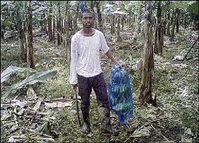
Farmer Roger Rampassard displays a bunch of bananas reaped from his four-acre holding in Toms River, Portland. - Contributed
At a time when banana farmers are encouraged to diversify into other sectors as a result of the downturn in the industry, 23-year-old Roger Rampassard recognised that his survival in the agricultural sector meant he had to be involved in more than just banana production.
Rampassard explained that he started agriculture as a chicken farmer with earnings from odd jobs he had done with his brother-in-law. This, he said, was enough to begin his agricultural venture without the need to seek a loan.
He began chicken production four years ago with only 100 birds, but still was not satisfied with just settling for what he could rear.
Meeting growing demand
Challenging himself to produce more to satisfy a growing demand for chicken meat, Rampassard gradually moved from 100 to 400 birds.
With supplies beefed up, he had to find new markets. It was, therefore, no surprise that he targeted supermarkets, restaurants, community shops, hotels and schools within the parish.
Other aspects of agriculture also caught the attention of the youngster. For one, he lived in a Portland community whose mainstay is banana and plantain production. After watching the years of dedicated service given by his parents to farming, he, too, wanted to follow in their footsteps.
His father passed on four acres of the family land to the youth for the production of bananas.
Willingly accepting the challenge, Rampassard quickly started banana production. Planting bananas was something he loved, especially the financial rewards.
Fruits, once reaped, stayed no time in storage, as there was a burgeoning demand from vendors, community shops, supermarkets and the lucrative export market he enjoyed through the Banana Export Company.
Still, Rampassard is reminded of the risks he face as a farmer during the hurricane season.
Reflecting on the impact of Tropical Storm Gustav, Rampassard explained that he suffered severe damage, which resulted in the loss of profits. Shortly after the storm, he replanted the affected field and is now in the process of reaping the mature fruit.
Other challenges he faces are the spiralling cost of production material, spray oil and, most important, fertiliser.
Rampassard further explained that with the export market virtually non-existent, gone are the days when farmers could supply produce to a guaranteed market.
As a consequence, banana farmers were now depending on the local trade to ensure the industry's survival or diversification to ensure their continued existence.
Already, he has plans are afoot to add dasheen to the list of items he cultivates for the local market. Unlike banana, dasheen will not be affected by hurricane winds or the escalating cost of inputs. More important, he will not have to wait a year or longer to realise financial gains.
Dasheen, Rampassard explained, is a lucrative crop, with turnover rates of six to eight months, depending on the wetness of the land.